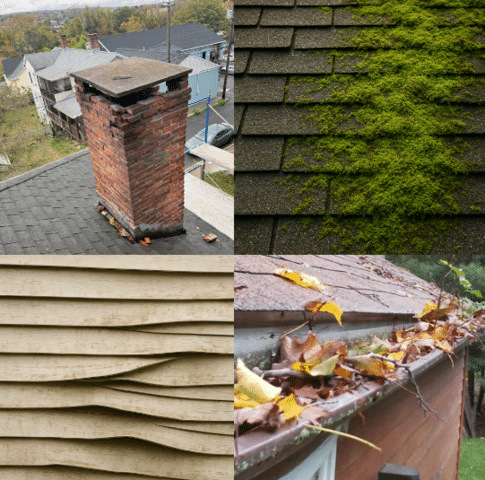Fall Roof Readiness

As autumn leaves start to fall and temperatures dip, your roof, siding, gutters, and chimney quietly prepare for the season ahead. But before the first frost arrives, it’s crucial to make sure your home’s exterior is ready to handle New England’s freezing temperatures, snow loads, and ice dams.
Here’s what every Connecticut homeowner should look for—and why fixing issues now can save you from costly winter damage later.
1. Your Roof: The First Line of Defense
Your roof is the shield that takes the brunt of winter’s fury—snow, ice, and high winds. Fall is the perfect time for a comprehensive roof inspection.
What to Look For:
- Missing, cracked, or curling shingles – Even a few can expose the underlayment and decking to water infiltration.
- Dark streaks or moss growth – Signs of moisture retention and potential wood rot underneath.
- Loose flashing around chimneys or vents – A major cause of winter leaks.
- Soft spots or sagging – May indicate hidden water damage or rot.
Why It Matters:
When temperatures drop, water expands as it freezes. That means any small leak in October can become a serious roof failure in January. Repairing or replacing compromised shingles before the freeze ensures your home stays warm and watertight all season long.
2. Gutters & Downspouts: Your Roof’s Drainage System
Your gutters are your roof’s drainage system—and if they’re clogged with leaves or debris, melting snow and ice have nowhere to go.
What to Check:
- Clogs or blockages – Leaves, sticks, and granules restrict flow.
- Sagging or separation from fascia – A sign that heavy debris or ice has warped the system.
- Leaking seams or rust – Common in older gutter systems.
Why It Matters:
Clogged gutters lead to ice dams, one of the most damaging winter roofing issues. When melting snow refreezes at the roof edge, it traps water beneath shingles, causing leaks, rot, and interior water damage. Cleaning your gutters—or upgrading to a Gutter Shutter leaf-guard system—prevents this entirely.
3. Siding: Protecting Your Home’s Thermal Envelope
Your siding doesn’t just make your home look good—it seals out moisture and insulates against the cold.
What to Look For:
- Cracked or warped panels – Let cold air and water in.
- Missing caulking or gaps at seams – Allow wind-driven rain and drafts.
- Mold or bubbling paint – Indicators of trapped moisture behind the siding.
Why It Matters:
Moisture that gets behind damaged siding can freeze and expand, leading to wood rot, insulation damage, and costly energy loss. Fall is the ideal time to repair or replace compromised siding before freeze-thaw cycles make small issues much worse.
4. Chimneys & Masonry: Safety and Stability
As temperatures drop, fireplaces and wood stoves become a warm centerpiece—but only if your chimney is structurally sound and clear of debris.
What to Inspect:
- Cracked mortar joints or spalling bricks – Allow moisture to seep in and freeze, causing further cracking.
- Damaged flashing – One of the top causes of roof leaks around chimneys.
- Creosote buildup – A fire hazard that needs annual cleaning by a certified chimney sweep.
Why It Matters:
Ignoring masonry damage or a blocked flue before winter can lead to chimney leaks, smoke backup, or even chimney fires. Addressing repairs early ensures both safety and comfort when you need heat most.
Why Fixing Issues Before Freezing Temps is Critical
Once the mercury dips below freezing, repairs become harder, slower, and more expensive:
- Sealants don’t adhere properly in the cold.
- Shingles become brittle and can crack.
- Ice and snow make access dangerous and delay scheduling.
By handling repairs now, you’ll:
- Prevent water intrusion before it turns to ice.
- Avoid emergency winter service calls.
- Lock in better pricing and faster scheduling before the late-season rush.
Final Word: Get Ahead of Winter with a Fall Inspection
Whether it’s your roof, gutters, siding, or chimney, an ounce of prevention in the fall can save thousands in the winter. Brown Roofing’s certified inspectors specialize in finding small problems before they become major leaks or structural issues.
Schedule your free fall inspection today and make sure your home is winter-ready—from top to bottom.


.png)